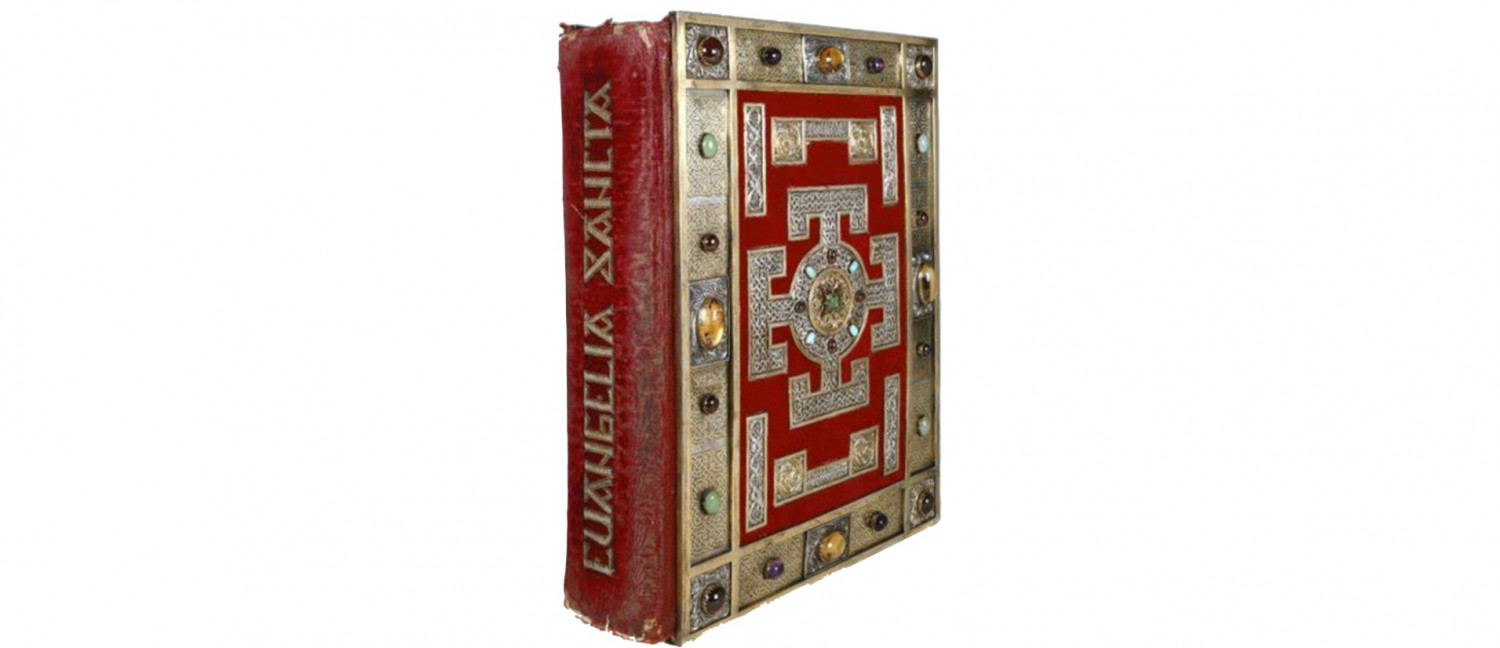
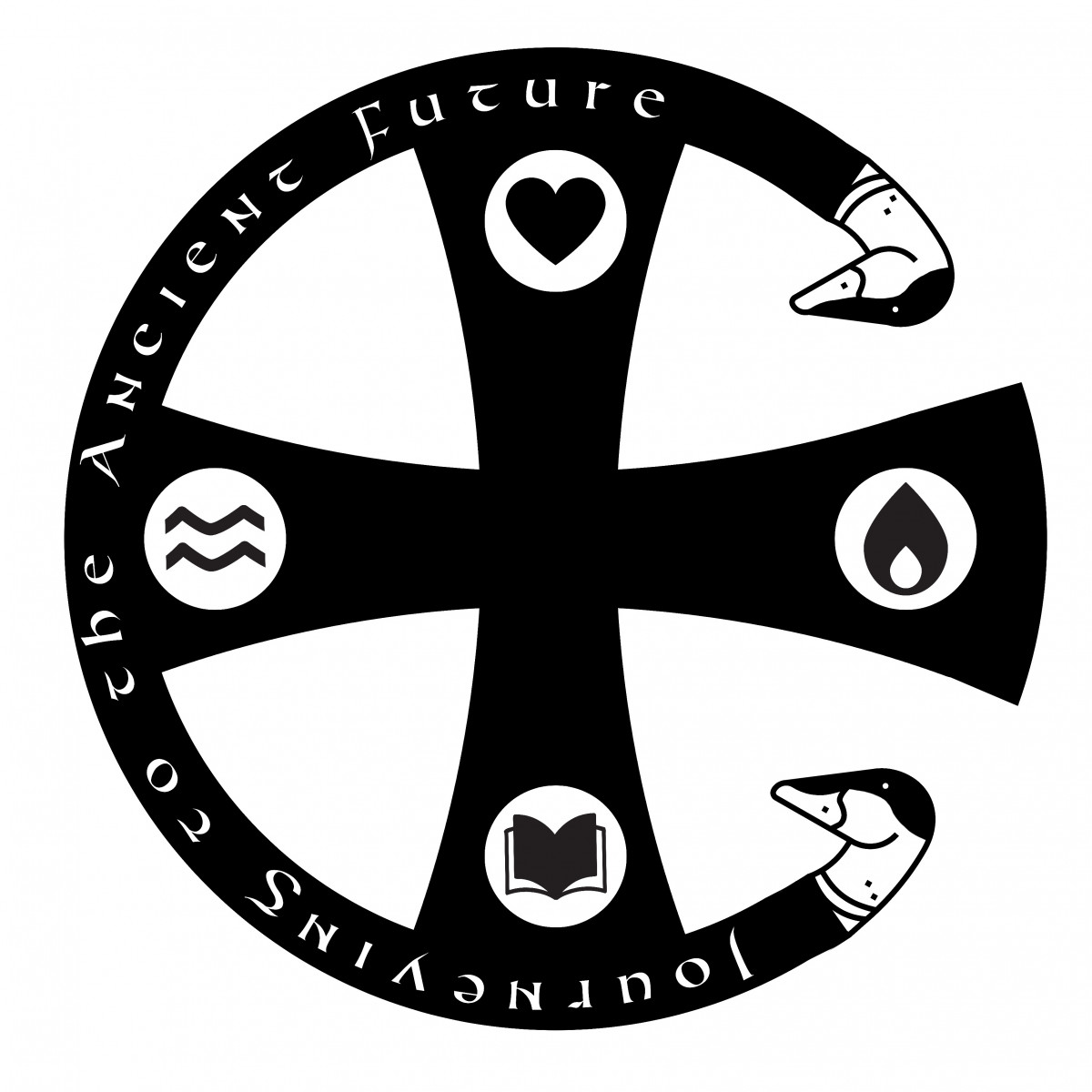
Lindisfarne Gospels Pilgrimage Reflection PowerPoint
David Pott (Durham Diocesan Pilgrimage Consultant and lead on the Lindisfarne Pilgrimage) has placed some of his memories of the pilgrimage in a personal and reflective PowerPoint, which can be found here.
Important Notice
In the light of the death of the Queen many events have been cancelled, but the partners in the project have decided that the pilgrimage will go ahead, but in a greatly modified form. As carrying the coffin at this time could be misunderstood and cause offence, it will now be transported by car to the schools and churches we will be visiting. A compelling reason for going forward is that we feel the Queen herself would have wanted the pilgrimage to take place. Like St Cuthbert, she was a gospel person whose faith was well known and who always mentioned something about the gospel in her Christmas message. We will provide opportunities for people as we walk to share memories and gratitude for the Queen and to reflect at this time of entering a new era.
The iconic Lindisfarne Gospels will be returning to their homeland with a display at The Laing Art Gallery in Newcastle from 17 September until 3 December 2022.
To celebrate this occasion, a challenging 130 mile journey will be undertaken with pilgrims carrying a replica of St Cuthbert’s Coffin containing facsimiles (from the Religious Resources Centre) of the Lindisfarne Gospels and Cuthbert’s Gospel of John from the River Tees to Lindisfarne itself.
Journeying to the Ancient Future
This pilgrimage will be about learning from the past, to live well in the present and to contribute towards shaping a better future. This is a summary of the ancient story we will tell in imaginative and creative ways as we travel…
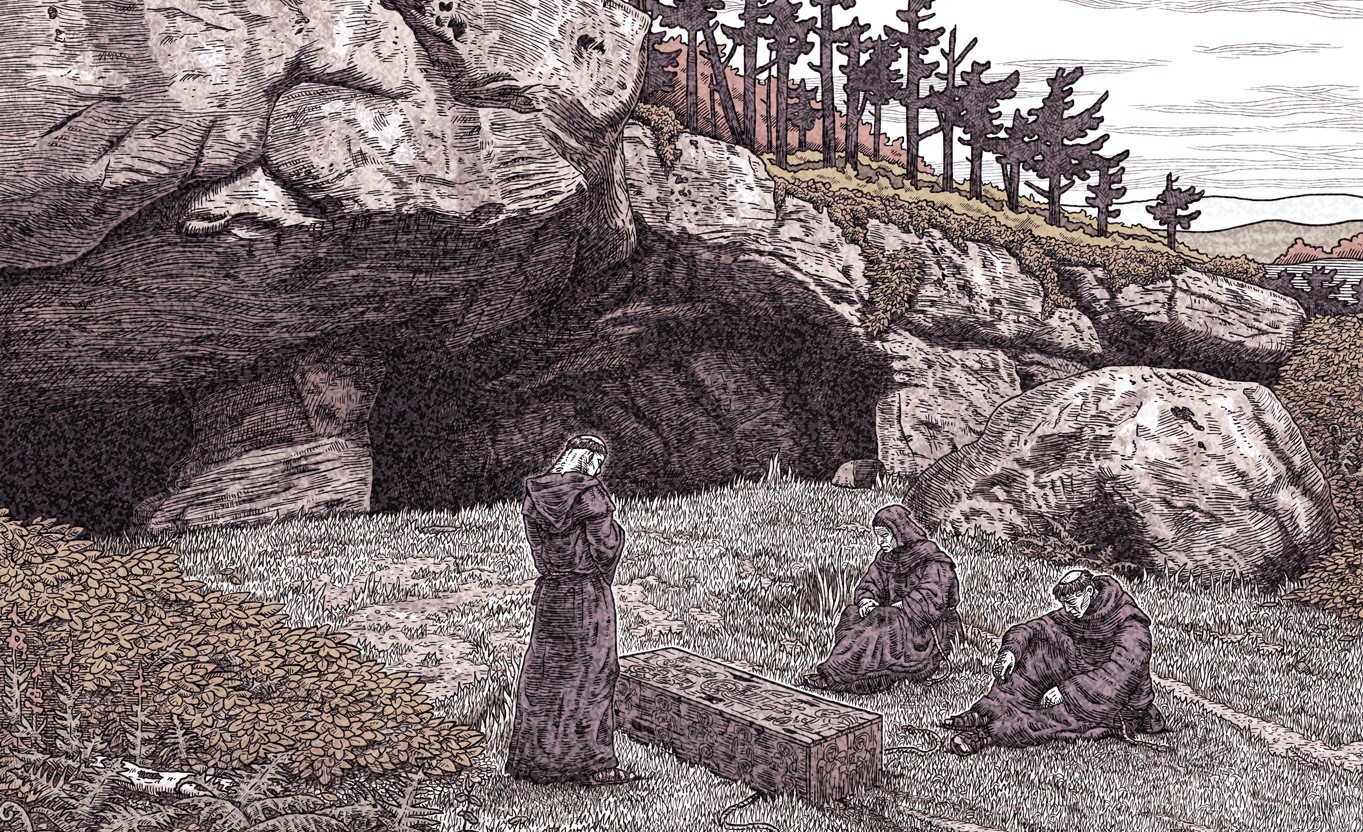
St Cuthbert’s coffin with monks by St Cuthbert’s Cave from the album cover of Take Up My Bones by Arð - Artist: Gabriel Danilchik
The Lindisfarne Gospels were written some years after the great St Cuthbert died in 687. When the Vikings attacked Lindisfarne in 793, the monks fled, taking with them a coffin containing the body of St Cuthbert along with Lindisfarne Gospels and other relics. When it was safe they returned, but further Viking raids led to more coffin journeys between 875 and 995. The stories of these wanderings of St Cuthbert in the coffin became a foundational myth for the region. A monk called Symeon of Durham writing in 1107, likened it to the wilderness wanderings of the Hebrews carrying the Ark of the Covenant. As the people of Israel were fashioned through their forty years in the wilderness, so the identity of people of the North East was shaped by these stories and their affection for “Cuddy” - their nickname for St Cuthbert.
To help us live well in the present and shape a better future, we will focus on three themes that were prominent in the life of St Cuthbert and are also major themes in his favourite gospel of John. They are Love, Life and Light.

- Love. St Cuthbert was a man of great compassion. He reached out to the needy and marginalised, especially when he travelled to remote parts of Northumbria where people were illiterate and very poor. As we seek to follow St Cuthbert’s example, we will be supporting the charity Feeding Families.
- Life. The original stories of Cuthbert are about the way he seemed to live on after his death. It was said that his body had not decomposed when they opened his coffin before interring him at Durham Cathedral, more than 300 years after his death. Although we will be carrying a coffin, we will be talking about life. Gospel means ‘good news’, so we will be carrying the good news that if we follow the example of St Cuthbert in following Jesus Christ, we will know life in all its fulness!
- Light. A 10th century poem describes how through St Cuthbert “God's shed His radiance gleaming across the water and Britain.” His life was suitably celebrated through a great illuminated manuscript. Light for us is therefore associated with creativity and we want to encourage creative responses to the pilgrimage especially through decorative handwriting.
The route of the pilgrimage
The final journey of Cuthbert’s coffin in 995 was from Ripon to Durham. One of the possible crossing points for the coffin across the Tees was Gainford and this is where the pilgrimage will begin. The route will continue via the historic Saxon church at Escomb and Bishop Auckland to Durham. Remembering the fact that the monks were originally intending to take the coffin to Lindisfarne, the route will continue to Chester-le-Street where the coffin and the gospels found their longest resting place and where the interlinear translation in early English was inserted. From there we will continue to Newcastle Cathedral, arriving on the day the Lindisfarne Gospels Exhibition opens. We will then proceed to the coast at Seaton Sluice, before following near the coast to Lindisfarne itself.
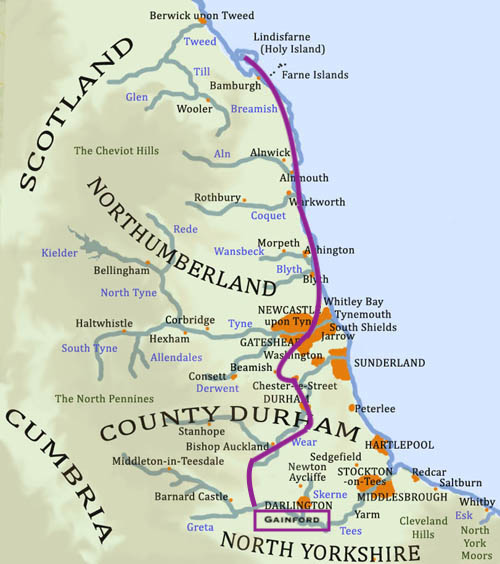
This is an approximate map of the proposed route. It is appropriate that the whole can be completed on or close to pilgrimage routes, using four of the newly established Northern Saints Trails along with St Oswald’s Way.
The Way of Life between Gainford and Durham
The Way of Learning between Durham and Chester-le-Street
The Angel’s Way between Chester-le-Street and Seaton Sluice
The Way of the Sea between Seaton Sluice and Warkworth
St Oswald’s Way from Warkworth to Lindisfarne
Click here to find out how you can join the pilgrimage and an updated, detailed plan of locations and timings.
Partnerships
The pilgrimage is a partnership project and the lead partners are the dioceses of Durham and Newcastle. The pilgrimage is their main contribution to events in connection with the Lindisfarne Gospels Exhibition.
Other partners include:
- The North East Religious Learning Resources Centre

- The Northumbria Community

- The Auckland Project
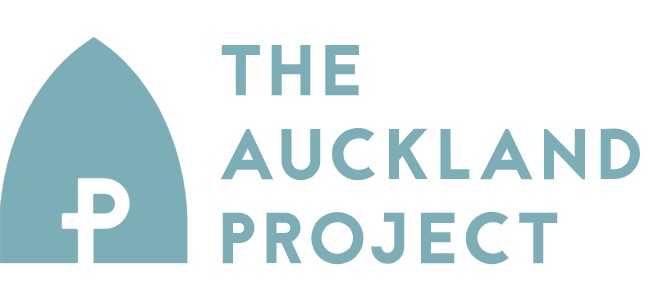
- The Friends of the Finchale Camino
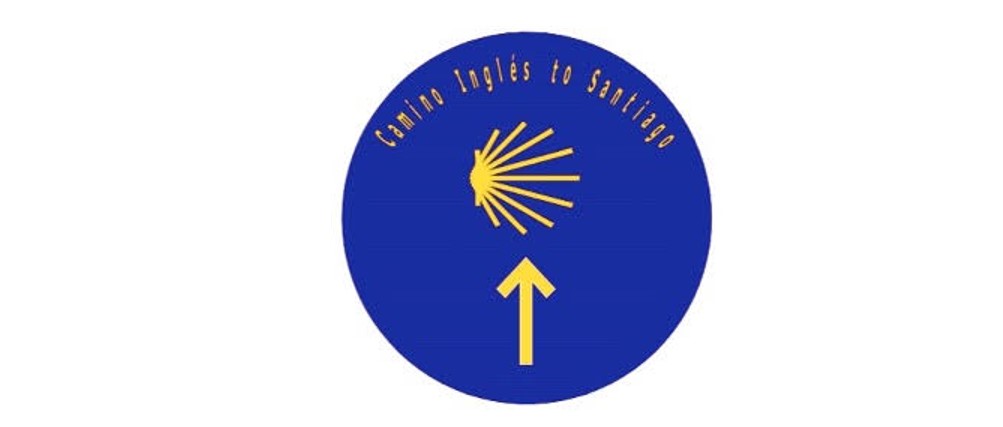
- Jane Crawford of Daisy Arts

Joining the Lindisfarne Gospels Pilgrimage
You are welcome to join the pilgrimage but please note the following:
- Three locations are indicated for each day, the first is the starting point, the second is an afternoon meeting point and the third is the finishing point.
- Apart from the start time, other times are approximate.
- The miles indicated are cumulative for each day.
- Please bring your own food with you and see to your own transport arrangements.
- Please check the forecast and ensure your clothing and footwear are suitable.
- You may have to wait at times when we give presentations in schools. Some schools may allow additional walkers in, but we cannot guarantee this.
- We have a schedule to keep, so we are unlikely to be able to wait if you are a bit slow!
- Please could you email dlpott@gmail.com to indicate when you are joining the pilgrimage and if you are able to help with carrying the coffin which should be a moving experience. As we will often have school children with us, we hope to cap it at a maximum of 20 extra pilgrims to avoid being too large a group. This will not apply on the Saturdays and Sunday.
- Please note that while we will take resonable precautions to ensure your safety, you join the pilgrimage at your own risk.
- For any more enquiries before the pilgrimage ring David Pott on 07932 790525 and during the pilgrimage itself ring Paul Gray on 07790 810039.
A full timetable is available here.
Lindisfarne Gospels Pilgrimage t-shirts
We now have specially designed t-shirts available for sale. You can order either a t-shirt with just our logo on the front or one with the logo on the front and also the pilgrimage plan with locations we are visiting on the back.
Please click here for information about how to order and purchase.
Final Concert
There will be a special concert to conclude the pilgrimage at St Mary's Church on Lindisfarne at 7.30 pm on Saturday 24 September. Alana Levandoski is a contemplative folk songwriter from Canada and a graduate of Richard Rohr’s Living School for Action and Contemplation. The distinguished poet Malcolm Guite will also be taking part. More information is available here.
What we can offer schools and youth groups
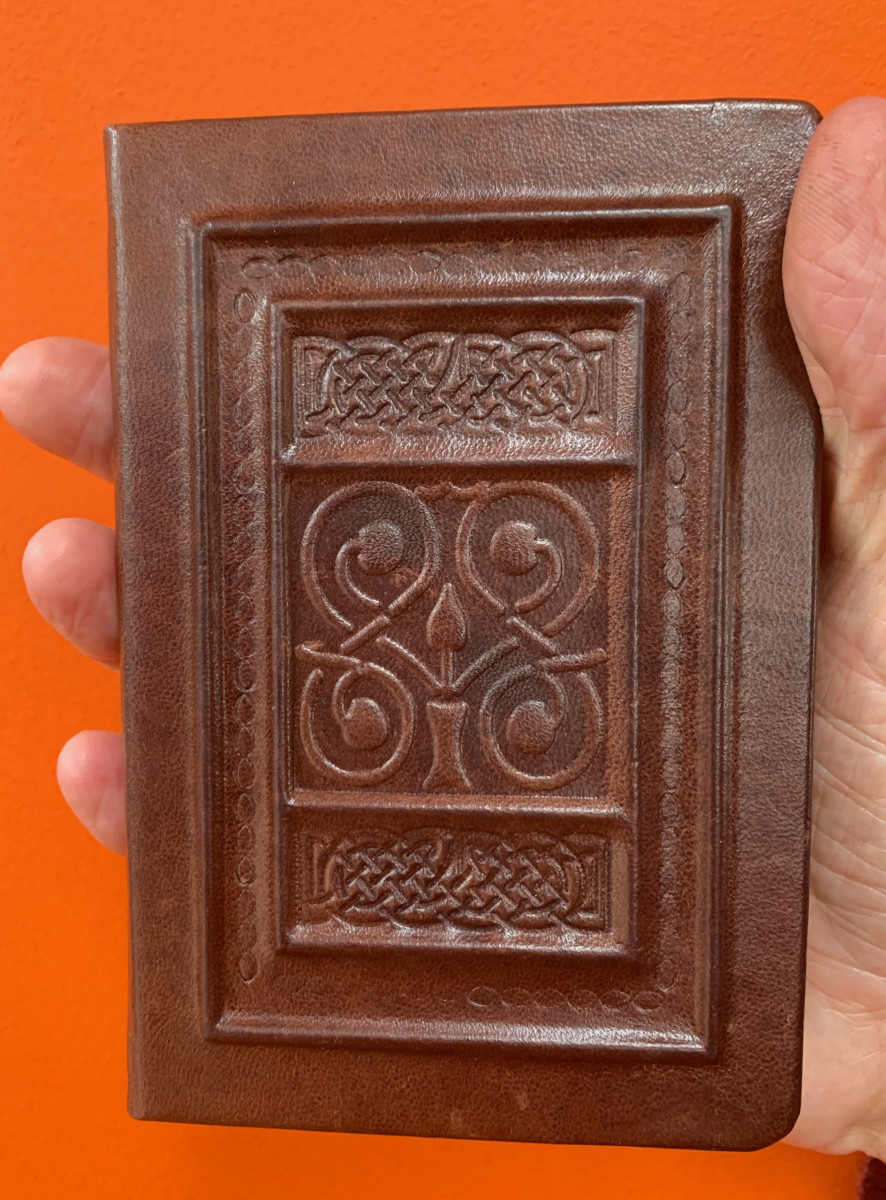 There is a strong educational element to the pilgrimage and we are able to offer the following to schools:
There is a strong educational element to the pilgrimage and we are able to offer the following to schools:
-
A presentation at the school either before or when the pilgrimage passes by your school. At that presentation or when the pilgrimage passes your school, we hope to show facsimile editions of The Lindisfarne Gospels and St Cuthbert’s Gospel of St John. The two books make a striking contrast with the bejewelled Lindisfarne Gospels weighing nearly 9 kgms and St Cuthbert’s Gospel only measuring 14 x 9cms. Some pupils will be able to handle these books. On the pilgrimage itself pupils will be able to see the specially made replica of St Cuthbert's coffin
-
Our hope is that the Lindisfarne Gospels will be a starting point for learning about calligraphy and for inspiring creative responses from pupils, such as decorative handwriting expressing hopes and prayers for peace. There are parallels between the Viking incursions and the Russian invasion of Ukraine. Some of the children's work will be displayed on online galleries on the Durham and Newcastle Dioceses facebook pages. We hope work by pupils might also be displayed in churches and community centres along the route after the pilgrimage.
-
We shall be able to supply some resources in connection with the Lindisfarne Gospels through our partnership with the Religious Learning Resources Centre in Durham who are also loaning the facsimiles. These resources will include complimentary copies of Discover The Lindisfarne Gospels which would be appropriate for years 2-6.
Church Involvement
We would very much welcome the involvement of churches on or close to the route. That involvement could include the following:
- Churches will generally be appropriate places where the coffin and the gospels can stay overnight. It has been suggested that some form of prayer vigil with candles might be appropriate, but it would be good to enable local people to come and see the coffin and the gospels. It would be very much up to local people to determine what they would like to do. Of course it would be important to ensure the church is secure for the night after the evening event.
- We are looking for accommodation each night which could be in people’s homes or perhaps in churches or church halls.
- We would like to find one person to be a local organiser for each day of the pilgrimage and if your church is able to find such a person please let us know
The New Haliwerfolk
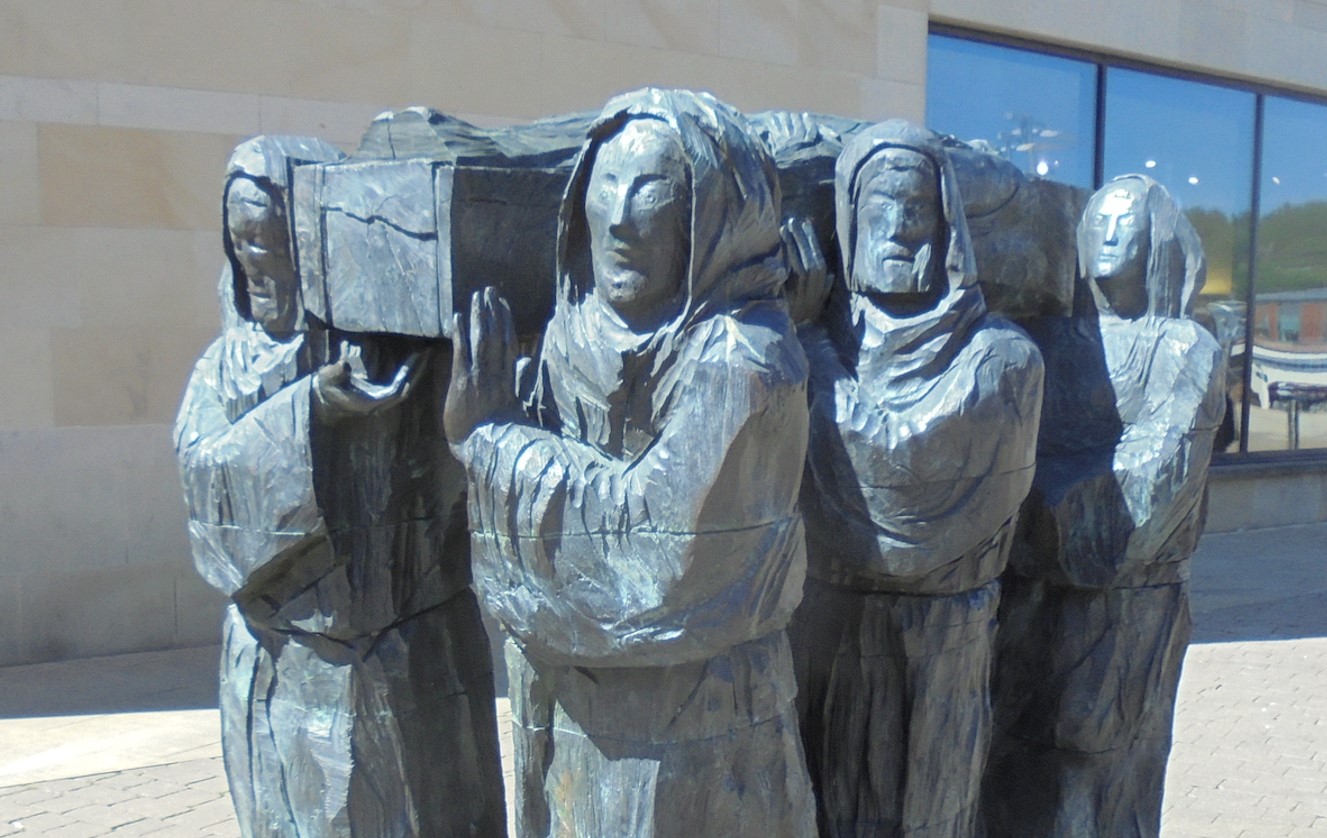
The core team on the pilgrimage will consist of 7 people which is exactly the same number that was assigned to take care of St Cuthbert’s coffin and the gospels in the original journeys.
One of the most interesting aspects of the original coffin journeys was that the people who guarded and traveled with St Cuthbert’s coffin were called haliwerfolk. The word is made up of three words with hali meaning holy and wer meaning man, so the whole meaning was “people of the holy man or saint.” Over time the word was extended to mean not just the descendants of the original attendants of St Cuthbert, but all those who had a special attraction and affection for St Cuthbert as a model follower of Christ. Later still, it was not just the people, but also the whole area between the Tyne and the Tees that became known as Haliwerfolk in just the same way that Norfolk and Suffolk became county names.
Those who will be carrying the coffin may well be called “new haliwerfolk.”
About our logo...
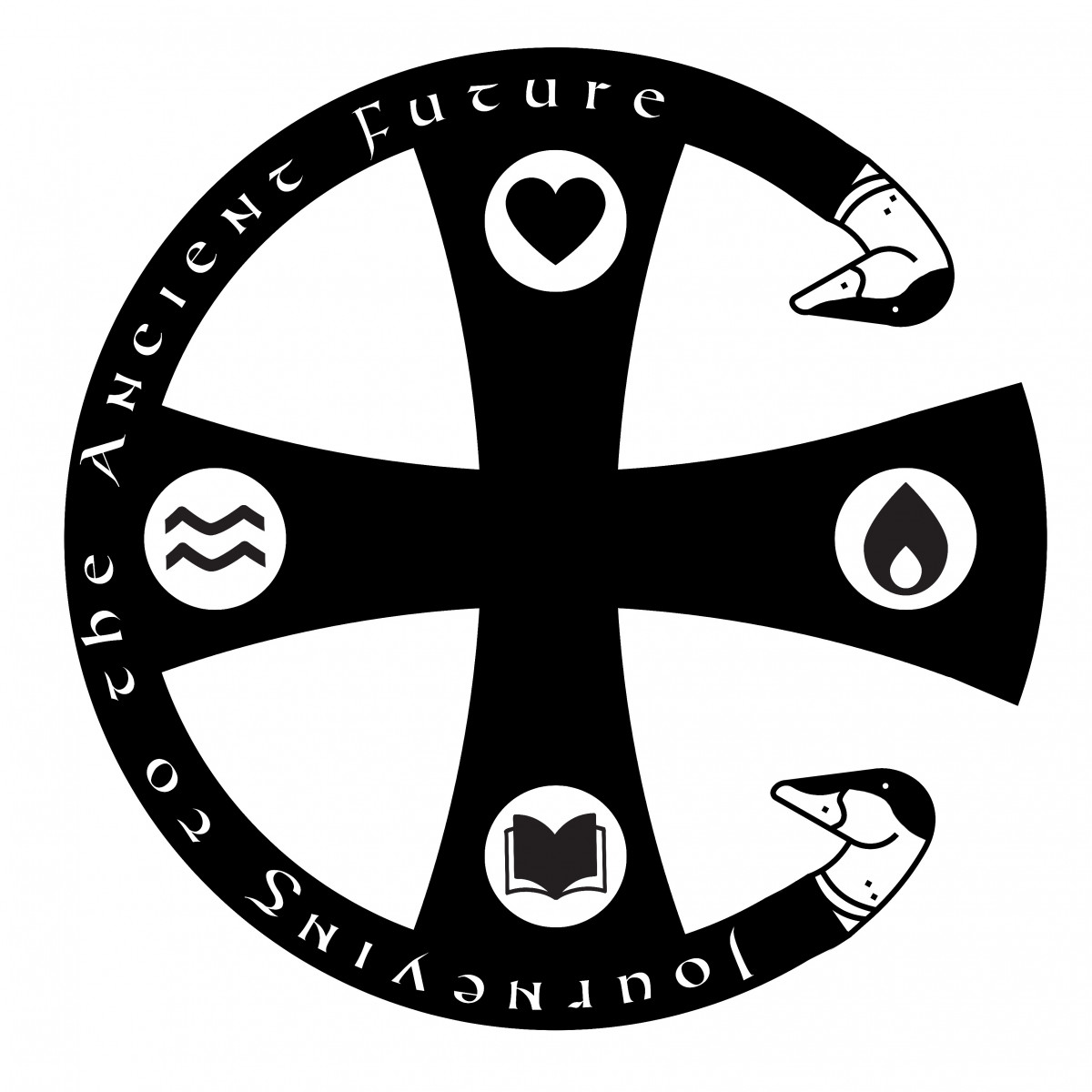 The letter C does not just stand for Cuthbert or for the coffin, but also for the cross which is central and also especially for Christ. Carrying the coffin is in some ways analogous to carrying the cross. The cruel cross symbolised Roman oppression and death and yet Jesus totally transformed its meaning by dying on it. In the same way, the coffin is perceived as very much associated with death and yet our coffin we trust will have a transformed meaning as it will contain the Word of Life. The symbols for love, life and light are key themes for us and very prominent in Cuthbert's favourite gospel of John. The book symbolises the gospel as well as learning. The ducks are actually eider ducks which are often called cuddy ducks after St Cuthbert. They remind us of St Cuthbert's great love for creation.
The letter C does not just stand for Cuthbert or for the coffin, but also for the cross which is central and also especially for Christ. Carrying the coffin is in some ways analogous to carrying the cross. The cruel cross symbolised Roman oppression and death and yet Jesus totally transformed its meaning by dying on it. In the same way, the coffin is perceived as very much associated with death and yet our coffin we trust will have a transformed meaning as it will contain the Word of Life. The symbols for love, life and light are key themes for us and very prominent in Cuthbert's favourite gospel of John. The book symbolises the gospel as well as learning. The ducks are actually eider ducks which are often called cuddy ducks after St Cuthbert. They remind us of St Cuthbert's great love for creation.
A final word…
In the late 10th century, Aldred, who was provost of the community in Chester-le-Street and who inserted his translation in early English into the Lindisfarne Gospels, added some valuable information at the end of the book. He mentions that Eadfrith, the Bishop of Lindisfarne “wrote this book for God and St Cuthbert.” In both the planning and the execution of this pilgrimage, we can do no better than adopt the same purpose. May all that is done “for God and St Cuthbert” be a rich source of encouragement, enlightenment and blessing for all who participate.
Contact:
David Pott
Pilgrimage Consultant
Diocese of Durham
Mob:07932 790525
Email: dlpott@gmail.com